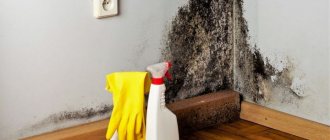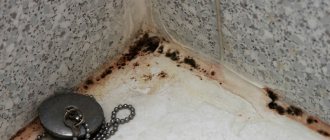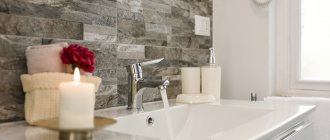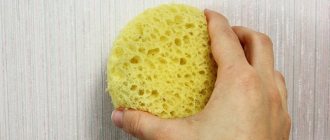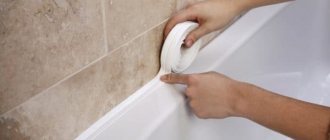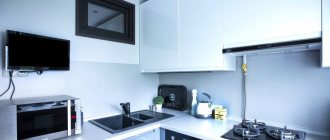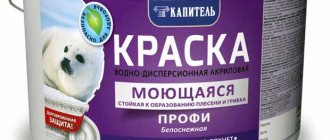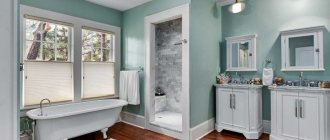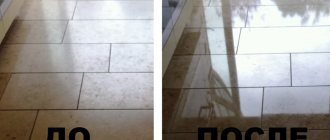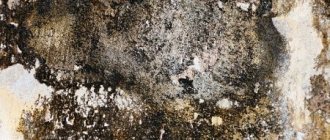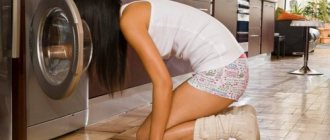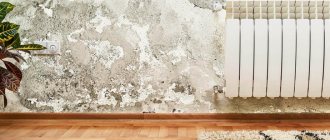Mold always appears in damp, poorly ventilated areas. The fungus also grows where there is little sunlight and high air temperatures.
The bathroom is an ideal breeding ground for mold. When cleaning this room, do not miss the first signs of fungal development.
Small black spots can be easily eliminated using modern household chemicals or using folk remedies. If mold occupies the bathroom thoroughly, then it will be much more difficult to fight it.
This article will tell you how to remove mold from the bathroom ceiling, how to clean the areas between the tiles on the wall, what products will help you quickly get rid of black fungus yourself, and how to use them correctly.
Existing methods of getting rid of fungus and mold
If, despite taking preventive measures that were not taken in a timely manner and therefore did not give the desired result, mold appears in the bathroom, get rid of it immediately. Delay in this case threatens the spread of fungal colonies throughout the room - they will move from the walls to the ceiling, and begin to affect the floors, mirrors, and furniture.
We use folk remedies to remove fungus from the surface in the bathroom.
There are many “grandmother’s” ways to combat harmful fungi - this is treating the contaminated surface with products that can be found in any housewife. You can also clean surfaces using technologies that use special aggressive antiseptic solutions.
Safety precautions when treating a room for mold
Any procedures for removing mold from the surface of walls are considered unsafe for health, because spores are easily transferred to human skin and then provoke diseases. In addition, during chemical treatment, caustic alkaline components are used, which also have a negative effect on the condition of the skin.
To protect yourself from harmful effects, it is recommended to use the following:
- durable rubber gloves for hands;
- respirators that protect the respiratory system;
- plastic glasses.
During cleaning, various protective equipment should be used, and upon completion of the process they should be disposed of.
Since during the cleaning process you have to scrape off the dark deposits from the walls with a spatula, dust settles everywhere. Therefore, it is recommended to first remove glasses, hygiene products and other small items from the bathroom. It is better to cover large items with thick oilcloth.
In addition, no strangers, children, or pets should be present in the room during cleaning. After completing the procedure, you should not enter the bathroom for several more hours.
At the same time, we recommend reading the article on the topic - How to clean a toilet from urinary stones, where you will find step-by-step instructions for cleaning the toilet, as well as practical tips for care.
General recommendations
It is necessary to disinfect shoes against fungus, even if a person does not suffer from nail fungus.
It is worth disinfecting your feet, shoes and socks regularly, especially when visiting baths, saunas and swimming pools. Antifungal drugs are bought at the pharmacy or used folk remedies. Antifungal treatment of shoes for toenail fungus involves creating an unfavorable environment for a long time for the fungus located in the fabric of the inside of the shoe. To destroy mushrooms, you need to create an acidic environment. This is achieved by soaking shoes with vinegar or its vapor for 24 hours. To effectively disinfect each area and type of surface, different means are used. Everything that the patient regularly touches needs to be disinfected:
All things that have come into contact with nails infected with fungus must be disinfected.
Common Types of Mold
This is the name given to filamentous formations that form a single multicellular structure. Mold multiplies quickly, the main manifestations being stains on surfaces. Plaque of organic origin can have a different shade. The most dangerous types of mold:
Chaetomium globosum causes damage to wallpaper, window frames, books, and so on.
- Chaetomium globosum, or biodestructor. Found on coatings and things containing cellulose. Mold affects wallpaper, drywall, window frames, books, paintings, etc. At the initial stage, the fibers are characterized by a white color. Gradually the shade changes to olive with a gray undertone or black. This type of mold is most dangerous for people prone to developing allergies. Provokes the appearance of symptoms of asthma, rhinitis, and respiratory diseases.
- Cladosporium herbarum. Promotes the development of negative reactions in allergy sufferers and people not exposed to pathogenic particles. This type of mold is not always black in color. Colonies may be olive or brown in color. This is a type of mold that destroys various objects. It is found on any things, lining, etc. Other types of mold in this group: Chaetomium, Ulocladium, Aspergillus, etc.
- Blue fungus. Modifies surfaces - they acquire a characteristic color. The fungus develops in conditions of high humidity and affects objects made of coniferous wood. It can be found in private houses, rarely in an apartment.
Exotic ways
In some cases, mold can be dealt with by applying baking soda to the mold-affected seams. But in this case, the abrasive properties of the substance are used rather; soda is not able to fight deep lesions. Some homeowners have tried eliminating mildew and mold using expensive products like tea tree oil and grapefruit seed extract. But, firstly, tea tree oil has a strong specific aroma that does not disappear for a long time, and secondly, these drugs are more suitable for prevention than for active control, when blackness is visible from everywhere. In such cases, mold can only be removed with the help of specialists.
Replacing grout joints
Sometimes it is not possible to clean mold using these products. Then you will have to make repairs, of course, you will not need to completely change the tile covering, but you will have to redo the seams.
How to do:
- if mold stains appear on the sealant and cannot be removed with special means, then they should be redone. First of all, we clean the mixture using a nail, spatula or other device;
- Next, you need to purchase a grease for seams with an antifungal and moisture-resistant effect. It is advisable that it be on sealant. The sealant does not allow moisture to pass through;
- Apply the mixture to the gaps of the tile covering using a rubber spatula.
Sequence of actions when replacing grout
Causes
Black mold, which is not so easy to get rid of, appears in the bathroom for a number of reasons. These are high humidity, improperly processed materials or poor ventilation. Before choosing a method to remove mold in the bathroom between the tiles on the floor or wall, it is worth learning more about the reasons for its appearance. Eliminating them will reduce the likelihood of fungal growth.
Humidity
The main reason why it is difficult to get rid of black mold is the constant humidity in the bathroom. The fungus loves dampness, and it is impossible to get rid of it in the bathroom for very obvious reasons. Splashes of water and steam condensation constantly settle on surfaces, promoting the growth of mycelium.
Darkness
Electric lighting is not enough for the bathroom; mold spores thrive under it. The presence of a window through which sunlight penetrates could improve the situation a little; it would be easier to remove the fungus in the bathroom - it dies under the influence of ultraviolet radiation.
Poor ventilation
Getting rid of fungus in the bathroom will be difficult if there is no free air circulation. In a confined space, moist air will not be able to escape, thereby the moisture concentration will increase, which is favorable conditions for the development of mold spores.
Lack of antiseptics
Some wall and floor coverings are treated with antiseptics at the production stage, but do not think that this is enough. Seams or joints, as a rule, remain unprotected, water can penetrate there, and black mold will gradually develop there.
How to deal with mold on curtains
Many housewives are not aware of the existence of harmful fungi on the curtains in the bathroom. Unlike fungus on the walls, mold on a dark curtain is not visible, so the more often you wash the curtain, the higher the chances of avoiding the growth of fungi.
- You can fight moldy fungi that have attacked the curtain with white.
- Using a colorless sponge, apply Whiteness to the moldy spots and wait a couple of minutes.
- When the mold disappears, it is better to rinse the curtain under running water to wash off the whiteness.
- Next, you should wash the curtain in a washing machine or by hand with powder.
- You can remove mold from a curtain using chlorine bleach. Be careful and carefully read the instructions for use. Bleach can not only remove fungal stains, but also ruin the color of the curtain.
Where does the fungus come from?
Fungal spores are present to a small extent in almost all rooms, as they move through the air with great ease. But their further development occurs only in a certain environment.
Important! If you do not promptly pay attention to small black or greenish spots in the corners or between the tiles, the lesions will begin to grow in all directions. The bathroom is an ideal environment for fungus to spread. It’s warm there and, most importantly, regularly high humidity
The fungus successfully settles and multiplies on any surface, be it wood, plastic, tile
It is warm there and, most importantly, there is regularly high humidity. The fungus successfully settles and multiplies on any surface, be it wood, plastic, tile
The bathroom is an ideal environment for fungus to spread. It is warm there and, most importantly, there is regularly high humidity. The fungus successfully settles and multiplies on any surface, be it wood, plastic, tile.
Fungus under a microscope
The main causes of fungus and black mold in the bathroom
Before you start fighting black and gray plaque on the ceiling and walls, you need to identify the main reason for its appearance.
The main factors for the occurrence of fungus in the bathroom:
- High humidity due to leaky taps;
- Wet towels;
- Lack of ventilation or low intensity;
- Lack of natural light;
- Cast iron pipes and cold walls, on which condensation often forms;
- Weak heating of the heated towel rail;
- Water constantly drawn into the bathtub and other open containers.
The presence of several items from the list of factors is quite enough for the manifestation of mold or mildew. To prevent such troubles, you can act like this:
- Install an additional hood or mount a fan on the main hood;
Healthy! You can install a fan using a special technology so that it starts working after turning on the light in the bathroom and, accordingly, turns off when the light is turned off. - Instead of cast iron pipes, install plastic ones;
- Insulate the walls of the room;
- You can buy a heater or a powerful towel dryer.
Chemical substances
On sale you will find a variety of products that help cope with pathogenic organisms. Customer reviews indicate that among this abundance there are the most effective products.
IMPORTANT. The drugs contain components that are unsafe for health. Processing should be carried out with gloves and a respirator. Please note that the chlorine contained can damage metal and delicate surfaces; they can be protected by covering them with a thick cloth.
Сillit Bang anti-stain
The antiseptic copes well with old and ingrained mycelium. It softens dirt, which is then easy to clean with a brush or knife.
Move the spout on the bottle to the “ON” position. Spray the liquid, keeping a distance of at least 10 cm to the target area. Wait 15 minutes, wipe the area with a dry cloth and wash off any remaining consistency.
REFERENCE. It has been proven effective against an existing colony, however, this method will not protect against new infections.
ASTONISH Mold & Mildew Remover
The product is fast and effective.
Spray the contaminated sealant with a spray, leave it for a few minutes, then wipe the surface with a damp sponge and rinse with water.
If at the end you find particles of mycelium, repeat the procedure.
Veksa Bathroom cleaner
The concentrate not only destroys spores, but also blocks their further appearance.
Apply the drug to the target areas, wait 15 minutes. We clean off the dirt with a brush and rinse with water. If necessary, we will repeat the operation.
IMPORTANT. Do not allow the product to dry on the surface. Frequency of use – 2 times a month (for preventive purposes).
Unicum
The components of the drug are able to penetrate and act in hard-to-reach places - gaps, cracks, etc.
Apply the liquid to the sealant, wait 3 minutes, work with a sponge and wash off the dirt.
Izocid (IZOCID ANTI-MOLD)
The advantage of this drug is that it does not contain any dangerous compounds, you can work with it without personal protective equipment, and it is compatible with all types of materials. This highly effective product destroys all types of mold and has proven itself in preventing infections.
Before processing, remove large mold growths with a knife. Shake the liquid, spray evenly, moisten generously. We wait 24 hours, remove the remains of fungi with a brush, and wash the surface.
You can repeat the procedure if necessary.
Processing socks
Treating socks for nail fungus involves boiling them in a special solution or treating them with a pharmaceutical antifungal agent. Boil socks in a solution prepared from available materials - soap and soda. They are mixed in the amount of 100 grams of baking soda, 50 grams of laundry soap and 5 liters of water. The pharmaceutical product “Formidron” kills all types of fungal infections on fabric, the same thing happens if you use the “Alaminol” washing solution. During treatment, it is recommended to change stockings more often so that the fibers of the fabric do not have time to multiply new microorganisms and re-infect them.
How to remove mold and protect yourself from its occurrence
If fungus appears, you need to know exactly how to deal with mold on the ceiling in the bathroom. But first, let's figure out how to protect ourselves from the appearance of colonies in the future.
To do this, adhere to the following rules:
- Ensure proper operation of the ventilation system. If necessary, clean the ducts and air ducts in a timely manner.
- Do not allow the ceiling to get wet for a long time. Repair pipelines, repair the roof and solve the problem with neighbors who constantly drown you.
- If you decide to install a film stretch ceiling, provide ventilation grilles in it in advance.
- If the bathroom has window openings, which is often the case in a private house, then ensure that sunlight enters the room. Ultraviolet light kills fungal microorganisms.
- When installing a ceiling in a private house, use all the necessary layers - insulation, vapor and waterproofing.
- Dehumidifiers can be used to reduce indoor humidity levels.
- To dry clothes, select a balcony or loggia, or dry it outside.
- After washing in the bathroom, turn on forced ventilation for 15 minutes or leave the door open.
Mold removal
Now let's figure out how to remove mold from the ceiling in the bathroom. The appearance of fungal colonies can be guessed by the characteristic unpleasant odor in the room and stains on the walls and ceiling.
To get rid of fungus, prepare the following:
- stepladder;
- rollers and wide brushes;
- antifungal impregnation;
- tray for liquid solutions;
- spray;
- protective gloves for hands;
- putty knife;
- respirator;
- polyethylene film.
We carry out the work in the following order:
- Cover the floor and plumbing fixtures in the bathroom with plastic wrap.
- Wet the ceiling with water by spraying it from a spray bottle. After the finishing layer is well soaked, remove it to the base using a spatula. This must be done for the reason that mushrooms grow into the structure of the plaster or finishing material.
- When cleaning affected surfaces, grab 150mm of clean finish on each side. This is explained by the fact that fungal spores do not immediately germinate on the surface, but may be present in the structure of the material.
- Next, thoroughly wash the concrete ceiling and let it dry.
- We carry out antiseptic treatment. Apply the antifungal agent to the ceiling using a brush or roller. After applying the first layer, let it dry for a couple of hours, then repeat the treatment. If desired, you can apply the primer in three layers.
- After the impregnation has dried, we restore the finishing ceiling covering in this area.
Actions in case of severe damage
Sometimes neither folk remedies, nor industrial antiseptics, nor professional devices help - the mold is nested too deeply and tightly and does not want to leave its habitat. Then the time comes for extreme measures - completely replacing the old grout with a new one. The procedure is as follows:
- Remove old grout.
- Clean the seams.
- Apply primer.
- Apply fresh grout.
Removing grout between tiles
First, it is necessary to completely remove the grout between the tiles to destroy the mold habitat, and apply new one. This can be done in various ways:
- mechanical - using a special tool (construction knife, dremel, joint spreader, electric drill), the grout is cleaned from the space between the tiles; this must be done carefully and carefully so as not to damage the tiles themselves and the enamel on them;
- chemical - special chemical reagents are used to soften the grout composition and facilitate its removal. They come in industrial grade - special solvents that do not damage the tiles: Keranet;
- Clean Kiilto;
- MasterGood; and folk ones - made from improvised means: a concentrated solution of vinegar or citric acid;
- a mixture of one part glycerin and three parts water;
- a mixture of water and kerosene or white spirit.
When removing old grout, you must not forget about protective equipment, since in the process you can get damaged by a tool or a flying piece of grout, and with the chemical method, you can get burned by reagents.
Cleaning seams and applying primer
After removing the grout, the tile joints must be thoroughly cleaned of old material. To do this, you can use an ordinary vacuum cleaner. After this, the seams must be washed with a solution of soap or a non-aggressive detergent and allowed to dry completely within 24 hours.
Next, a layer of penetrating primer is applied to ensure better adhesion of the grout to the surface and greater surface protection.
Applying fresh grout
The next step is to apply fresh grout. To protect it from mold, there are two ways:
- use a special anti-fungal grout - it already contains all the additives necessary to prevent the fungus from appearing and spreading. Such grouts can be found in the line of companies: Ceresit;
- Fuga De-Lux;
- Kerapoxy Design;
- Litokol and others;
- Ceresit CT-10;
To be more confident, you can combine these two methods - this option will be a little more expensive and labor-intensive than each of them separately, but will add reliability and protection against fungus.
Antifungal impregnation gives the grout water-repellent properties, protects against mold and dirt
At the stage of renovation of the bathroom, when we completely changed its appearance and, accordingly, re-tiled the walls, it was decided to use a special anti-fungal grout from the company Ceresit, and in addition to it, an anti-fungal impregnation for grout from the same company. It cost a little more than if we had bought simple grout, but it paid off in the future. Despite the lack of ventilation, frequent baths and our laziness, due to which we rarely wipe the tiles dry, 5 years after the renovation we still did not know what mold is.
Folk recipes
There are quite a lot of remedies for mold and mildew in the bathroom, which can easily be prepared from what is in the kitchen cabinet. They can easily cope with the problem when the mycelium is not yet too large. Let's consider the most popular means.
Vinegar
An excellent remedy for black mold in the bathroom, acetic acid is found in every housewife. Acetic acid can be used on its own or as part of a more complex anti-fungal treatment.
The easiest way to clean grout or slabs is to apply acetic acid to all areas affected by mold. Wait 10 minutes, then scrub the seams well with a sponge and rinse the surface with warm water.
Baking soda
You can treat the bathtub against fungus using regular soda. It is enough to mix the soda slurry in a small bowl and apply it to the seams with a regular brush. Clean the joints thoroughly and rinse off any remaining soda with water. Don't forget to wipe the tiles dry.
Using soda you can remove not only mold, it perfectly cleans any dirt. However, you should understand that cleaning with baking soda will only last for a short time.
Tea tree essential oil
You can remove mold from bathroom grout using tea tree oil. It is enough to dilute it (2 teaspoons) in warm water (2 tbsp.) and apply the resulting liquid to the tiles using a spray bottle. Leave the oil solution on the tiles; there is no need to wash it off. To prevent the smell from disturbing household members, cleaning can be done at night or when no one is home.
Acidic solution
You can kill fungus in the bathroom using a solution of boric and acetic acid with hydrogen peroxide and water in proportions 1: 2: 2: 4, respectively. Wipe the affected areas well with the prepared solution.
Anthracene oil
Unlike previous products that can be used to clean off mold in the bathroom on tile seams, anthracene oil is used only to prevent the occurrence of fungus. When using this product, keep in mind that the oil has a pronounced unpleasant odor; the room must be ventilated.
Borax
At home, you can get rid of fungus in the bathroom using borax, mixing 1 glass per 2.5 liters of water. The mixture is applied to the affected areas after cleaning with other means; there is no need to rinse off the solution, but the surface should not be left wet. To remove excess moisture, wipe the tiles with a dry cloth or paper towels.
Camphor
It will only help at the initial stage of mold infection. To combat a dangerous fungus, simply place a few balls in the corners and places most susceptible to infection.
Iodine
Iodine vapor is also a good remedy that will help fight fungus in the bathroom. It is enough to add 10 mg of iodine to a glass of water, and simply leave the resulting solution on the shelf.
Borax processing
To treat moldy areas in the bathroom, use sodium tetraborate or borax.
- Dilute one glass of borax in two and a half liters of water.
- Wipe the moldy areas in the bathtub with the solution using an old brush.
- Wipe off any remaining sodium tetraborate with a cloth.
- It is not recommended to wash off the borax; it is better to treat the surface with a dry cloth to remove moisture.
Prevention
Getting rid of fungus on bathroom walls is very difficult; it is often a long process, and mold is tenacious. It is much easier to take measures against its appearance, this will reduce the risk of mold development, and if it does appear, prevention will help to quickly cope with the problem. Here are some useful tips to help prevent black fungus from appearing on tiles and other surfaces:
- Since humidity is perhaps the primary cause of mold, its level must be carefully monitored. It should not exceed 30%.
- The bathroom needs to be well ventilated, so make sure you have a quality fan.
- After showering, always open the door for a while.
- If you plan to make repairs, be sure to treat all surfaces with an antiseptic before finishing.
- Monitor the condition of pipes and plumbing; there should be no leaks, and all minor accidents must be repaired immediately.
- Perspiration often appears on metal pipes, so they should be replaced with polypropylene.
- Be sure to treat all joints and seams with sealant, especially the gaps between the bathroom and the walls.
- After washing, you should not dry clothes and linens in the bathroom.
- Hanging shelves, soap dishes and cups for brushes must always be dry, otherwise they may also develop fungus.
- You should not choose furniture made of wood; this material is vulnerable to fungus and quickly deteriorates.
Following simple rules for preventing the appearance of black mold at home will help avoid this scourge. If the fungus does appear, you need to get rid of it as quickly as possible.
So, the more advanced the case, the more difficult it is to get rid of black mold. To avoid having to do a major overhaul of the entire bathroom, it is better to immediately prevent the development of fungus by regularly cleaning and monitoring the humidity level. Good sealants, dryness and constant air circulation guarantee the absence of mold.
Places where mold stains occur
We seem to have figured out the reasons, now it’s worth finding out in what places spots of black or green fungus may appear. This will simplify the work and also save processing costs.
In the bathroom, fungal accumulations often appear in places:
- black or green spots often fill the seams of the tile covering;
- fungus may appear in the corners of the room;
- at the junctions of walls;
- Sometimes mold can be found in the shower stall, between the shelves, in any spaces between cabinets and walls.
Mold in the faucet area
Mold in the corner of the room
Basically, fungal spots appear in places with increased moisture accumulation. During the cleaning process, be sure to thoroughly wipe everything and check for mold stains.
Popular folk remedies against fungus
Since professional products to help fight fungus were not previously available in stores (they appeared relatively recently), our ancestors in the old days used solutions that were poisonous to mold. Of course, among them there are also dangerous ones for people, using which it is necessary to take protective measures. A man must:
- Wear special clothing;
- Hands should be protected by gloves;
- A respirator is suitable for respiratory protection.
In addition, when treating premises, children and animals should not be in the apartment. Before starting to treat the room, assess the size of the problem:
Black or brown spots in small quantities should not cause you much concern - they can be destroyed using a construction knife and a swab, which is moistened in a special detergent for plumbing.
To remove large lesions that have grown to sizes greater than 10 cm, a serious approach is required.
If the mold is already huge, spreading rapidly deep into the walls, and even penetrates into other rooms of the apartment, urgently call a professional team.
Creosote is a powerful and aggressive anti-fungal agent made from tar. Since ancient times, it has been used in the railway industry - it is used to treat sleepers and wooden building structures, protecting them from rot.
Creosote is a pungent, strong-smelling, oily liquid with a slight yellowish tint. It is difficult to dissolve in water, so it is diluted with ethers or alcohol. The product is very dangerous to health, therefore, after using it to remove mold, then rinse it well from the surfaces.
It is prohibited to treat wood paneling and furniture with creosote, since this strong agent can be absorbed into the loose structure of the wood, after which it cannot be removed.
Creosote can be used to treat concrete, ceramic tiles and bricks. After this, it is necessary to thoroughly wash the treated areas with detergents, and then rinse them with plenty of running water.
Creosote will remove even the most stubborn mold.
It is possible to destroy even long-grown mold with creosote, but remember that the product is aggressive and will ruin the wooden surface. Wear a respirator and rubber gloves. Fighting moldy fungi in this way is dangerous to health.
- Dilute creosote in oil or alcohol.
- Apply to mold-damaged areas of tile and grout.
- It is better to remove the remaining yellowish mass.
How to normalize humidity levels
Before removing mold, you need to create an unfavorable environment for its development. First you need to check if there are any undetected water leaks in the bathroom. This could be a drain hose from a washing machine, a hole in a pipe, or a leaky joint between a bathtub or shower stall and a wall. A never-drying puddle of water is a surefire way to maintain a high level of humidity in a room. The source of fungus is often the shower tray or the floor under the bathtub.
The second step to normalizing humidity levels is good ventilation. The ventilation duct is responsible for this. In old multi-storey buildings, ventilation is often poor. In this case, it is necessary to equip the restroom with an additional ventilation unit or purchase a dehumidifier. Don't keep the bathroom door closed. This is a bad habit that contributes to the accumulation of moisture in the room. Do not dry towels in the bathroom; take them to the balcony or another room with better ventilation.
What is a fungus and its types
A fungus is a microorganism whose spores are present in small quantities in all interior spaces, but certain conditions are required for their growth. The ideal environment for the proliferation of microspores is warmth, high humidity, and lack of sunlight. It is these conditions that are created in the enclosed space of the bathroom and are the main reasons for the concentration of fungal spores.
Black fungus can live and reproduce on any surface
Three types of fungus are found indoors:
- Rotting bacteria: brown, white, bacterial rot. These spores are found on wood surfaces or soil. If rot particles have penetrated into the wood fibers, it is impossible to remove them. Occasionally, white fungus can be found on the walls in a very damp room.
- Blue fungus. In city apartments, encountering it is extremely rare, because this type of fungus attacks wood. For bathrooms and bathhouses in country houses, blue mushroom is a real disaster. It not only spoils the appearance of the finish, but also destroys the wood.
- Black fungus is the most common type in bathrooms and a health hazard. Depending on the strain, it is gray or black in color. It has a loose structure and is poorly attached to the surface, so it scatters and stays in the air for a long time, penetrating the respiratory tract.
Why is fungus dangerous?
Fungal spores quickly become airborne, causing health problems for all residents. The lungs are the first to suffer .
If the mold foci are small, then at the first stage of contact with its spores, a person may feel:
- dizziness,
- general malaise,
- weakness.
If people are forced to live in a building that is heavily infested with mold, the complications will be very serious.
The fungus can cause allergies , manifested in persistent rhinitis or dermatitis. Spores in the air can lead to asthma and even cancer.
Traditional methods
Most folk remedies allow you to get rid of the external manifestations of the fungus for a while. You will remove traces of it from the surface, but its spores will remain in the material. And if so, after some time the spots will appear again. Only a radical solution to the humidity problem can help - effective ventilation. In a dry room, fungus/mold will not be able to develop.
Those who have fungus in the bathroom are ready to use all possible means to get rid of it
Using products that are harmless to humans
Regular vinegar and soda will help get rid of mold in the bathroom. There are several methods for using them:
- Wipe the walls with alcoholic table vinegar, leave for several hours, closing the doors, rinse with water, then ventilate.
- The method for horizontal surfaces is to pour baking soda, add vinegar, wait for the reaction to finish and rinse with water.
- Wipe the walls first with baking soda, then with vinegar, then with water.
It’s difficult to say how effective these mold remedies will be, but vinegar helps remove hardness salts perfectly - the white coating is washed off without a trace.
Baking soda and vinegar - you can try
The next folk remedy for fighting mold in the bathroom is peroxide. They also use it to wipe down walls. But we must remember that peroxide in large quantities is toxic and you need to work with a mask and gloves. Also, do not forget that it has a whitening effect. If you treat the grout in the joints between the tiles, it will become several tones lighter.
Disinfect with hydrogen peroxide
https://youtube.com/watch?v=BOSH9Q33oTI
Hazardous substances
In first place in terms of frequency of use are bleach and chlorine-containing detergents for cleaning plumbing fixtures - Belizna, Domestos, Utenok, etc. They are diluted with a certain amount of water, coated with walls, especially carefully treating the seams between the tiles. External manifestations (dark spots) go away very quickly, literally before our eyes. For some time after treatment, mold does not appear, but sooner or later (usually in the autumn or spring season) it begins to appear again.
When working with bleach and preparations made from it, you must wear gloves, a respirator and protective clothing. After treatment, it is advisable to turn off the ventilation (if there is forced ventilation), close the doors tightly, and not use the bathroom for some time. Chlorine does not remain in a free state for long, but at this time it is very active, including its vapors. This “gas” chamber will allow you to disinfect corners that cannot be reached with a brush.
You have to be careful with bleach and copper sulfate
The next most popular way to get rid of mold in the bathroom is treatment with a solution of copper sulfate. Take 100 grams of powder, dissolve it in 10 liters of water and treat the walls and ceiling with this solution
The precautions are the same as when using bleach. The results, in principle, are not very different either - temporary relief from black marks.
https://youtube.com/watch?v=2TlZINFfumU
Products used for repair work
To avoid mold contamination of walls for a long time, builders use highly effective fungal repellents.
Copper sulfate and special primers or emulsions applied to the wall will not only completely destroy the fungus that appeared before the repair, but will also prevent its reproduction in the future.
Let's take a closer look at how these tools work:
How to remove mold stains with copper sulfate?
This is one of the most effective remedies for fungus. Copper sulfate, which can be bought for 150 rubles, can protect walls from mold for a long time.
To treat surfaces, dilute the following solution:
- take 100 gr. vitriol;
- 10 liters of water.
Apply the product to the wall with a brush . In places where the fungal infection is very strong, the wall is covered with a solution in several layers.
When 3-4 hours have passed, the wall is washed and dried.
Copper sulfate must be handled very carefully because this product is very toxic. When working with it, you need to ventilate the room well, and also use a respirator and gloves.
Antiseptic emulsions
These drugs include antifungicides that protect against biocorrosion. They are made on the basis of QAC (quaternary ammonium compounds) and guanide.
One of the best products for the bathroom is “Renogal” for 360 rubles, which can remove mold even from the seams between the tiles.
The following tools are also popular among users:
- antiseptic “Abedis 06 Barwa Sam” for 250-300 rubles;
- “Snowball Puma” for 80-100 rubles;
- emulsion “Alpina Ground” for 300-350 rubles.
Primers
Before using these products, you need to prepare the surfaces. A layer of whitewash or paint is removed from the walls and ceiling, and the plaster is dried using a hair dryer.
You need to work in a respirator so that mold pores do not enter the respiratory tract.
The finished walls and ceiling are treated with an antifungal emulsion or other product.
Among the popular means:
- “Ceresit CT-99” antifungal primer costing 360-400 rubles;
- primer "Caparol Capatox" for 650-700 rubles;
- "Bairis BioStop" for 200-250 rubles.
Treatment and basic procedures
The fight against a disease in the form of a fungus is carried out by following a number of steps.
- Determining the source of occurrence. It can be located in a place that is inaccessible, for example, under a bathtub or at joints. The plaque that is visible is part of the fungus.
- Removal of the lesion. Areas of the room that are affected by fungal disease are cleaned. Next, you need to knock on the walls and find voids, which are then cleaned out.
- The areas that have just been cleaned should be cleaned, but dry heat is used for this purpose.
- The walls need to be treated with antiseptic agents. The remedy for fungus in the bathroom must have a good composition and a positive effect.
In addition to good adherence to basic recommendations, treatments are often used for treatment that have the maximum value, and in addition, many are folk remedies, which allows you to get rid of the disease in a short time.
Bending in the bathroom - struggle
Some tips for using the products
When planning to use one or another remedy for black mold, you need to take into account a number of features. Firstly, it is impossible to remove this scourge by washing off with warm soapy water with manganese. Even if it is possible to eliminate the black plaque, disputes will remain. Having received a new nutrient medium in the form of warm moisture and the components that make up the soap, their colonies will begin to multiply even faster.
It only takes two years for black mold to destroy building structures. In favorable conditions, she will not stop at the bathroom, but will capture new territories
Secondly, it is impossible to avoid the re-invasion of mold after removing it mechanically. The spores will remain and continue to reproduce.
Thirdly, high positive temperatures, as well as very low ones, are not able to destroy mold spores. Their presence will only stunt growth. Once favorable conditions return, the mold will continue to grow.
Fourthly, the smallest cracks in the bathroom wall need to be repaired, and the walls that are in contact with the street should be insulated. The rugs on the floor in this room should be dry, or even better, have a warm floor here.
Fifthly, it is advisable not to dry wet laundry in the bathroom. It will become an additional source of moisture. When zonal surface treatment does not help, you will have to make repairs throughout the entire room. For this purpose, purchase products intended for use during repairs. They are added to putty, paint or whitewash.
The process of renovating a bathroom is labor-intensive and requires both time and money. But it is almost impossible to deal with old mold in any other way.
Pay attention to primers that are based on acids and other components that have a detrimental effect on mold.
Destruction of fungus in hard-to-reach places
Mold in the bathroom most often occurs at the junctions of the floor and walls, as well as in the seams between tiles. Removing fungus and mold in this case involves mechanical action. Simply washing or scrubbing off a pathogenic formation will not work.
You can remove fungus in the bathroom between the tile seams as follows:
1. First, you should remove as much as possible the old grout that is affected by the pathogenic formation. This is done using a metal spatula or an old knife.
2. To completely remove all pores that have penetrated into deep deposits of putty or even concrete, you should wipe the joints with a stiff brush. A device of this type with soft metal bristles is often used.
3. Treat the cleaned seam with an anti-mold agent. What is the best way to treat the surface in this case? Any antifungal substance of chemical origin would be an ideal option. In this case, it is better not to use folk remedies - they are not so reliable in terms of disinfection.
4. After several days, when the trace of the antifungal substance has completely disappeared and no new areas of the infected surface have appeared, you can proceed to the final completion. The seams are rubbed with fresh grout and then covered with sealant.
It is very difficult to remove deeply penetrated mold or mildew, but this is a necessary condition for comfortable living and use of the bathroom. To remove mold that has affected only the damaged seams between the tiles, enough effort is applied, but this is not the maximum effect.
Pre-cleaning of seams
Mold grows quite quickly, and begins to negatively affect the health of people living in the apartment immediately after it appears, so steps to remove it must be taken as soon as possible, at the first signs of black spots and dots. In addition to the mold itself, it is necessary to find and eliminate the cause of its appearance as quickly as possible, otherwise the mold will come back.
Before starting to treat the seams with mold-killing preparations, it is necessary to mechanically clean the tile seams, removing all visible stains and stains. For this you will need:
- gloves;
- respirator;
- hard brush.
Armed with these improvised means, they thoroughly clean all seams to remove traces of mold. Once cleaning is complete, it is best to throw away all these materials, as fungal spores may have become exposed to them during the cleaning process.
The first step is to clean the tile joints from visible traces of mold.
You can quickly and efficiently prepare seams for cleaning from mold using a steam generator. The principle of operation of the device is to supply water steam at a very high temperature under strong pressure - such a jet easily “knocks out” accumulated dirt, visible mold spores, and lime deposits from surfaces. After this treatment, the seams are ready for deeper cleaning and the use of antifungal drugs. All you have to do is wipe the seams thoroughly and dry so that no droplets of water remain in them.
The steam generator supplies hot water steam under pressure, which allows for high-quality cleaning of tile joints
